Review Article - Volume 2 - Issue 6
A Study to Compare The Relation of Taste Threshold Between Type 1 and Type 2 Diabetes Mellitus
Latha GS1*; Meenakshi KR2; Smriti Sinha3; Manjubhargavi D4
1 Assistant Professor, Department of Physiology, RajaRajeswari Medical College and Hospital, Bengaluru, Karnataka, India.
2 Research Associate, Central Research Lab, RajaRajeswari Medical College and Hospital, Bengaluru, A Constituent Institution of Dr.M.G.R. Educational and Research Institute, Chennai, India.
3 Associate Professor, Mamta Academy of Medical Sciences, Hyderabad, Telangana, India.
4 Associate Professor, Department of Shalakya Tantra, Indian Institute of Ayurvedic medicine and Research, Bangaluru, Karnataka,India
Received Date : Sep 06, 2022
Accepted Date : Oct 17, 2022
Published Date: Nov 03, 2022
Copyright:© Latha GS 2022
*Corresponding Author : Latha GS, Assistant Professor, Department of Physiology, RajaRajeswari Medical College and Hospital, Bengaluru, Karnataka, India.
Email: lathavishnumahesh@gmail.com
DOI: Doi.org/10.55920/2771-019X/1282
Abstract
Taste disorders result from various diseases and drugs. Severe taste dysfunction leads to decreased food intake and poor nutrition. There are five established basic taste modalities, which are altered specifically, or may be affected generally. Diabetes mellitus is one of the diseases that affect taste. It is the most common endocrine-metabolic disorder affecting a large population. Two major type of diabetes are, Type 1 DM in children and adolescents and Type 2 DM in adults. Many studies have been done on alteration of taste sensation in type 1 or type 2 DM separately, mainly on four primary sensations of taste, without considering the umami taste in their study frame. Nevertheless, no comprehensive information is available on alteration of physiological taste threshold for different taste modalities, including umami taste in both type 1 and type 2 DM. Thus, the present study is undertaken with the objectives; to compare the alteration in taste threshold for five primary sensations in type 1 and type 2 DM. Materials and Methods: Investigations were carried out in thirty type 1 diabetic patients, aged between 12 to 35 years and in thirty type 2 diabetics patients aged between 40-70 years and in age and anthropometrically matched control groups of thirty, each for type 1 and type 2 diabetics separately, who were apparently healthy. Their age, health status and other personal data were obtained by comprehensive questionnaire. Statistical analysis was done using ‘Mann Whitney U test’. Results: The taste threshold for Salt and Sweet sensation significantly (p<0.05) increased in type 1 diabetics, compared to their controls. Similarly, the taste threshold for Salt and Sweet were significantly (p <0.05) increased in type 2 diabetics, compare to their controls. Furthermore, in Type 2 diabetics, taste threshold for Salt and Sweet were significantly (p<0.05) higher compared to type 1 diabetics. No difference in threshold was observed for Umami, Sour and Bitter tastes in any one of the diabetic group. Conclusion: Taste dysfunction was evident in both type 1 and type 2 diabetics and more so in type 2 diabetic patients. The increased taste threshold is specific, affecting Salt and Sweet modality mainly. Dysfunction of taste sensation should be detected in diabetics by screening. Measures to improve the food intake and supplementation for nutritional deficiencies can be given priority in diabetics.
Keywords: Taste threshold; salt; sweet; umami; sour; bitter; type 1 diabetes mellitus; type 2 diabetes mellitus; taste dysfunction.
Introduction
Taste is the sensory modality that guides organisms to identify and consume nutrients while avoiding toxins and indigestible materials. For humans, this means recognizing and distinguishing sweet, umami, sour, salty, and bitter-the so called” basic” tastes. There are likely additional qualities such as fatty, metallic and others that might also be considered basic tastes. Each of these is believed to represent different nutritional or physiological requirements or pose potential dietary hazards. Thus sweet-tasting foods signal the presence of carbohydrates that serve as an energy source. Salty taste governs intake of sodium and other salts, essential for maintaining the body’s water balance and blood circulation. We generally surmise that umami, the taste of L-glutamate and a few other L-amino acids, reflects food’s protein content. These stable amino acids and nucleotide monophosphates are naturally produced by hydrolysis during curing. Bitter taste is innately aversion and is thought to guard against consuming poisons, many of which taste bitter to humans. Sour taste signals the presence of dietary acids. Because sour taste is generally aversion, we avoid ingesting excess acids and overloading the mechanisms that maintain acid-base balance in the body. Moreover, spoiled foods often are acidic and are thus avoided. Nonetheless, people learn to tolerate and even seek out certain bitter and sour-tasting compounds such as caffeine and citric acid, overcoming innate taste responses. Variations in taste preference may arise from genetic differences in taste receptors and may have important consequences for food selection, nutrition and health.
An important, unrecognized aspect of taste is that it serves ‘functions’ in addition to guiding dietary selection. Stimulating the taste buds initiates physiological reflexes that prepare the gut for absorption (releasing digestive enzymes, initiating peristalsis, increasing mesenteric flow) and other organs for metabolic adjustments (insulin release, sympathetic activation of brown adipose tissue, increased heart rate etc). Collectively, these reflexes are triggered by the sensory (sight, smell, taste) recognition of food are termed as cephalic phase responses [1].
The taste threshold alters by number of factors such as age, ethic backgrounds, drugs, local and systemic diseases, consumption of alcohol, smoking and tobacco chewing. One of the factors, which alter the physiological taste threshold, is diabetes mellitus (DM).The pathophysiology of taste alteration in DM may be related to a decreased rate of turnover of the receptors [2] also, an association between taste impairment and diabetic neuropathies has been described, but remains disputed [3].
Diabetes is a group of metabolic disorders, characterized by hyperglycemia resulting from defects in insulin secretion, insulin action or both. The chronic hyperglycemia in diabetes is associated with long-term damage, dysfunction and failure of different organs, especially the eyes, kidneys, nerves, heart and blood vessels.
Type 1 DM may be due to β-cell destruction, usually leading to absolute insulin deficiency. This form of diabetes, which accounts for only 5-10% of those with diabetes, previously encompassed by the terms insulin-dependent diabetes, type 1 diabetes or juvenile-onset diabetes, results from a cellular-mediated autoimmune destruction of the β-cells of the pancreas.
Type 2 DM (ranging from predominantly insulin resistance with relative insulin deficiency to predominantly an insulin secretary defect with insulin resistance) is a form of diabetes, which accounts for ~90-95% of those with diabetes, previously referred to as non-insulin dependent diabetes, type 2 diabetes or adult onset diabetes, encompasses individuals who have insulin resistance and usually have relative rather than absolute) insulin deficiency. At least initially, and often throughout their lifetime, these individuals do not need insulin treatment to survive. There are probably many different causes for this form of diabetes. Although the specific etiologies are not known, autoimmune destruction of β-cells does not occur. Most patients with this form of diabetes are obese and obesity itself causes some degree of insulin resistance [4].
Many studies have been done on alteration of taste sensations in type 1 or type 2 diabetes mellitus separately, mainly on four primary sensations of taste, without considering the umami taste in their study frame. Nevertheless, no comprehensive informations are available on alteration of physiological taste threshold for different taste modalities, including umami taste in both type 1 and type 2 diabetes mellitus. Thus, the present study was undertaken with the objectives; to compare the alteration in taste threshold for five primary sensations in type 1 and type 2 diabetes mellitus. Most of the previous studies have used electrogustometry as the principle tool of investigation. However, in the present study the chemical gustometry method was used. It is more feasible method for testing patients on outpatient basis and so aids in timely management of decreased taste sensation.
Materials and Methods
The taste threshold for five primary sensations of taste was determined among the type 1 and type 2 diabetes mellitus patients, who are visiting the medicine department, KIMS,Hubli for follow up and in the control groups, we had age and anthropometrically matched apparently healthy individuals, including both males and females.
Inclusion criteria
- Thirty, type 1 diabetic subjects, of both sexes with the age ranging between 12 to 35 years, diagnosed at least one year prior to the study without any clinical evidence, suggestive of metabolic complications of diabetes.
- Thirty, type 2 diabetic subjects, of both sexes with the age ranging between 40 to 75 years, diagnosed at least one year prior to the study without any clinical evidence, suggestive of metabolic complications of diabetes.
- A group of thirty apparently healthy individuals, having age and sex matched with type 1 diabetes mellitus subjects.
- A group of thirty apparently healthy individuals, having age and sex matched with type 2 diabetes mellitus subjects.
Exclusion criteria
- Those subjects, who are on prescribed medicines, which are known to cause taste alteration like sulfonylureas, ACE inhibitors.
- Smokers and alcoholics
- Pregnant and lactating mothers
- Those subjects, with other taste altering causes like upper respiratory tract infection, herpes infection
- Newly diagnosed (within one year from the day /month of diagnosis) type 1 and type 2 diabetic patients.
After considering inclusion and exclusion criteria, the study groups were selected. The importance of the procedure was explained to the guardian and the subject. Informed consent was obtained from the guardian for subjects with age < 18 years and from the subject with age ≥18 years.
Determination of taste threshold
Stimulus representing the five classical basic tastes was included for testing the recognition of taste threshold for particular taste. Seven serial half dilutions of the stock concentration were made for each taste solution, by using deionized water and used for experiment. The starting concentrations were Glucose (2M), Sodium chloride (1M), Citric acid (0.05M), Quinine sulphate (0.001M) and Monosodium glutamate (1M). The concentrations obtained after seven serial dilutions are given in the table below. The taste sensitivity for each solution was investigated as per Harris and Kalmus method assisted by forced choice and up-down tracking procedure for better output and result [5].
Subjects were tested with two or three drops of the solution of lowest concentration on the dorsum of tongue to taste first and then made to taste successive higher solution until a definite taste was identified. Distilled water was used in between two solutions for rinsing. Rinsing of mouth was repeated untill the subject said that no taste of the previously tasted concentration lingers on. Accordingly, the actual threshold concentration was determined and the bottle number was noted [6] the following sequence was followed for taste recognition ie; umami, followed by Salt, Sweet, Sour and Bitter taste solution [7].
Table 1: List of tastant concentrations used
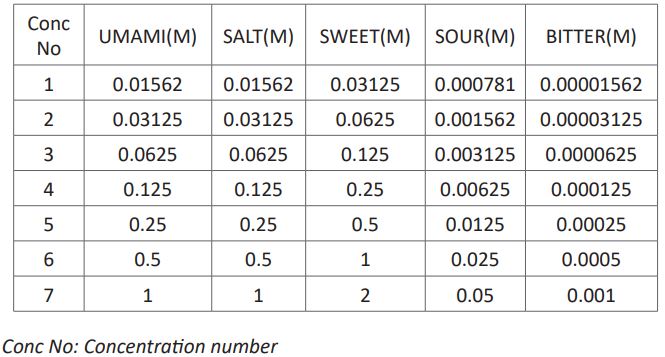
Source, Physical and chemical nature of the tastants used in the study
- Umami (L-glutamic acid monosodium salt, C5 H8 NNaO4 .H2O) white coloured crystal form, Manufactured by An ISO 9001:2008 Certified Company Kemphasol, Mumbai
- Salt(Sodium chloride, extra pure,NaCl) white colored powder form, Manufactured by HiMedia Laboratories Private Limited, Mumbai.
- Sweet (Dextrose anhydrous extra pure, C6H12O6) white coloured solid powder form, Manufactured byThomasBakerCompany,Mumbai.
- Sour (Citric acid, Na3 C6 H5 O7) white coloured solid crystal form, Manufactured byAlfaChem Laboratories, Mumbai.
- Bitter(Quinine sulfate [C2 OH24N2 O2 ].H2 SO4 .2H2 O ) white coloured fine powder form, Manufactured by S.D. Fine Chemicals Limited, Mumbai.
All tastants were kept in airtight plastic bottles and stored as per recommended by the manufacturer. About 2 ml Eppendorf tubes, 5 ml of sterile disposable syringes and deionized water was used to prepare the stock solution and seven serial dilutions. Fresh solutions were prepared and used within 24 h of preparation. Separate droppers were used for each tastant.
Statistical Analysis
Statistical analysis was done using the SPSS (Statistical Package for the Social Sciences) software. The statistical analysis was done using “Mann–Whitney U-test.” This is a non-parametric test used to compare two unpaired groups. This test was used to compare the threshold of different taste parameters p < 0.05 was taken as significant.
Results
The observation and results of the present study is as follows. In this study, the taste threshold in type 1 diabetic subjects is compared with type 2 diabetic subjects.
Table2: Comparison of taste response to different concentrations of monosodium Glutamate solutions and number of type 1 and type 2 diabetic subjects.
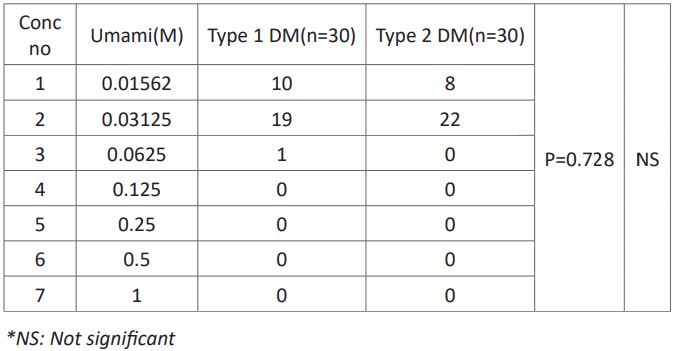
It is observed that at 0.03125 M and lower concentration twenty nine type 1 diabetics were able to recognize umami taste properly and all the thirty type 2 diabetics recognize it properly at the same concentrations. Thus, the threshold for umami taste sensation in type 2 diabetics is not significantly altered compared to type 1 diabetics.
Table3: Comparison of taste response to different concentrations of sodium chloride solutions and number of type 1 and type 2 diabetic subjects.
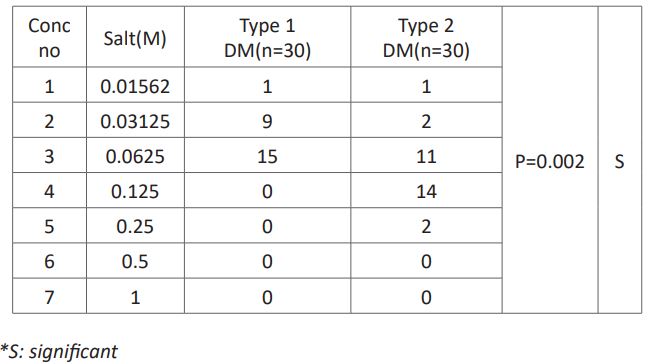
It is observed that at 0.0625 M and lower concentration twenty five type 1 diabetics were able to recognize salt taste properly while only fourteen type 2 diabetics recognize it properly at the same concentrations. Thus, the threshold salt taste sensation in type 2 diabetics is significantly altered compared to type 1 diabetics.
Table 4: Comparison of taste response to different concentrations of glucose solutions and number of type 1 and type 2 diabetic subjects.
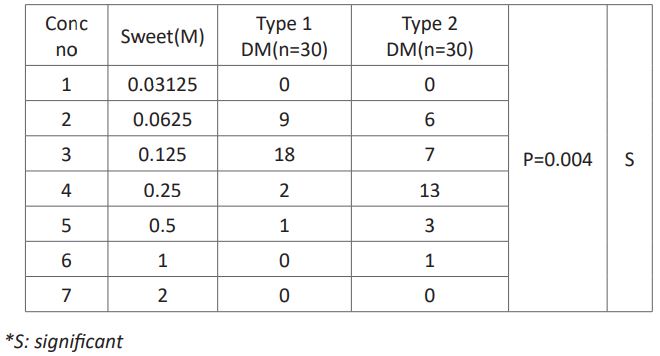
It is observed that at 0.125 M and lower concentration twenty seven type 1 diabetics were able to recognize sweet taste properly while only thirteen type 2 diabetics recognize it properly at the same concentrations. Thus, the threshold sweet taste sensation in type 2 diabetics is significantly altered compared to type 1 diabetics.
Table 5: Comparison of taste response to different concentrations of citric acid solutions and number of type 1 and type 2 diabetic subjects.
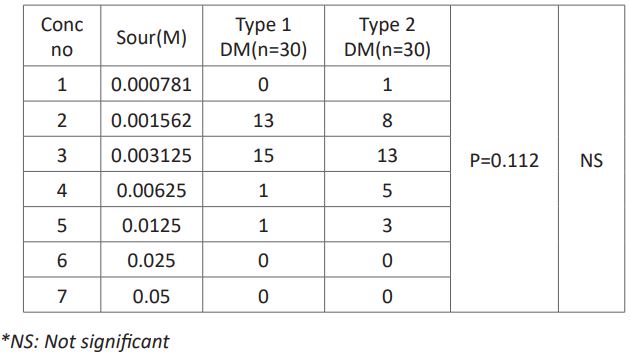
It is observed that at 0.003125 M and lower concentration twenty eight type 1 diabetics were able to recognize sour taste properly and twenty two type 2 diabetics recognize it properly at the same concentrations. Thus, the threshold sour taste sensation in type 2 diabetics is not significantly altered compared to type 1 diabetics.
Table 6: Comparison of taste response to different concentrations of Quinine sulphate solutions and number of type 1 and type 2 diabetic subjects.
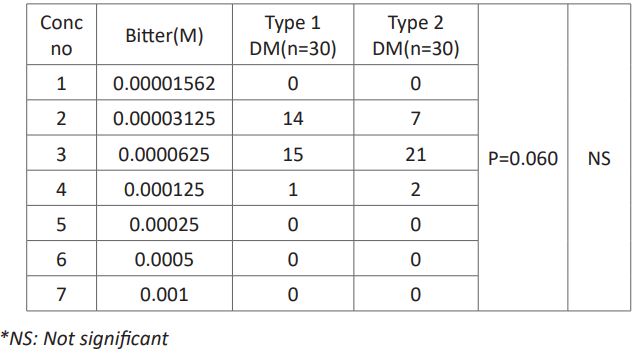
It is observed that at 0.0000625 M and lower concentration twenty nine type 1 diabetics were able to recognize bitter taste properly and twenty eight type 2 diabetics recognize it properly at the same concentrations. Thus, the threshold for bitter taste sensation in type 2 diabetics is not significantly altered compared to type 1 diabetics.
Discussion
Comparison of taste threshold for different taste modalities, between type 1 and type 2 diabetics in the present study revealed that Sweet and Salt taste threshold were significantly higher in type 2 diabetic patients compared to that of type 1 diabetics. The threshold for other taste modalities – umami, sour and bitter did not show any difference in between these two groups. In an earlier study conducted by Stolbova et al., hypoguesia and ageusia in both type 1 and type 2 daibetics were noted [8]. However, the difference in taste threshold between type 1 and type 2 diabetics were not compared in their study. Similar study by Jos Mojet et al., showed that the elderly have less specific taste acuity than the young. In their study they have observed that the salty and umami taste qualities seemed to be affected most [9].
The reason for the present study observations could be the difference in age among type 1 and type 2 diabetics. In this study the men age of type 1 diabetic group is 17.57 ± 6.1 years, whereas mean age of type 2 diabetics is 53.2 ±8.31 years. Normal aging is known to affect the chemical senses [2]. The possible explanation for this change is that the number of taste buds on the tongue has a connection with age and to how the body handles sugar. There appears to be a strong, negative, independent association between the density of the fungi-form papillae and also, between the density of the fungi-form papillae and the fasting plasma glucose [10].
Cooper et al., found in their study that, there is a general decrease in taste acuity in the elderly and concluded that the taste sensitivity remains unimpaired until the age of late fifties, after which it shows a sharp decline [11] similarly, Grad in his article reported that many elderly people have increased salivary sodium concentration [12] and higher taste threshold in them was due to salivary composition rather than a deficiency in the sensory apparatus [9]. Additionally, the development of neuropathy in diabetics correlates with the duration of diabetes and glycemic control [13].
In contrast, Anders A. F. Sima et al., in their study concluded that Diabetic peripheral polyneuropathy (DPN), affects type 1 diabetic patients more often and more severely. The Impaired insulin/C-peptide action is recognized as an important factor accounting for the increased burden of DPN in type 1 diabetic patients. It has regulatory effects on neurotrophic factors and modulatory effects on apoptotic phenomena affecting the diabetic nervous system. In animal studies, C-peptide has shown to improve nerve conduction abnormalities, prevents nodal degenerative changes, which are characteristic of type 1 DPN, promotes nerve fiber regeneration, and prevents apoptosis of central and peripheral nerve cell constituents [14].
Conclusion
There is no definite management strategy for decreased taste threshold in diabetics. Counseling and reassurance can be done in them, and the flavour of food can be enhanced. Salt is important for flavor enhancement. Naturally occurring umami-rich food can be used to enhance the flavor, which can be used in certain cases like diabetic nephropathy, diabetes associated with hypertension, where increasing the salt intake is not an option. Increasing the flavor of food helps in increasing the appetite, in turn immunity and overall health of an individual.
References
- Nirupa Chaudhari and Stephen D. Roper. The cell biology of taste 2010; 190(3): 285-296.
- Susan S. Schiffman. Taste and Smell in disease. The New England Journal of Medicine 1983; 308(21): 1275-1279.
- Le Floch JP, Le Lievre G, Labroue M, Peynegre R, Perlemuter L: Early detection of diabetics patients at risk of developing degenerative complication using electric gustometry: a five year follow-up study Eur J Med1992; (1): 208-214.
- American Diabetes Association. Diagnosis and Classification of Diabetes Mellitus. Diabetes Care 2010; 33(1): 62-63.
- Harris H, Kalmus H, Trotter WR. Taste sensitivity to phenylthiourea in goiter and diabetes Lancet 1949; 2: 1038-1039.
- Rahul S Khobragade, Santosh LWakode and Ashok H Kale. Physiological taste threshold in type 1 diabetes mellitus. Indian J Physiol Pharmcol 2012; 56(1): 42-47.
- Hai-Bo Shi, Muneyuki Masuda, Toshiro umezaki, Yuichiro Kuratomi, Yoshihiko Kumamoto, Tomoya Yamamoto, Sohtaro Komiyama. Irriadiation impairment of umami taste in patients with head and neck cancer. Auris Nasus Larynx International Journal of ORL and HNS 2004; 31: 401-406.
- K Stolbova, A Hahn, B Benes, M Andel, L Treslova. Gustometry of Diabetes Mellitus Patients and Obese Patients 1999; 5: 135-140.
- Jos mosjet. Elly Christ-Hazelhof and Johannes Heidema. Taste Perception with Age: Generic or specific Losses in Threshold Sensitivity to the Five basic Tastes?. Chem.Senses 2001; 26: 845-860.
- Chee W Chia. Type2 Diabetes. Aging & Diabetes2014; (736). Loss of Taste Buds with Age Connected to Diabetes? Advertisement.
- Cooper .R.M, Bilash.I and Zubek.J.P. The effect of age on taste sensitivity. J. Gerontol 1959; 14: 56-58.
- Gard B Diurnal, age and sex changes in the sodium and potassium concentration of human saliva. J. Gerontol 1954; 9: 276-286.
- Dan L Longo, Anthony S Faucl, Dennis L Kasper, Stephen L. Hauser, Larry Jameson J, Joseph Loscalzo. In Harrison’s Principles of Internal Medicine; 18th edition 2012; 2: 2968-2992.
- Anders AF. Sima, Weixian Zhang and George Grunberger. Type 1 Diabetic Neuropathy and C-peptide. Experimental Diabetes. 2004; 5: 65–77.

